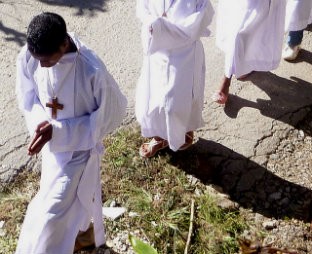Slaughter in East Timor

The Asian continent has two majority-Christian nations. One, obviously, is the Philippines. Few nonspecialists would know the other example: East Timor. Lying between Australia and Indonesia, it is one of the world’s newest countries—in fact the first new nation of the present century. East Timor is also definitively Christian, with a reported Catholic population of 97 percent. Those bare-bones facts, though, conceal a heroic and often dreadful history, recalling one of the world’s worst atrocities of the late 20th century.
For centuries, East Timor was a Portuguese colony. (The word Timor simply means “east.”) In 1974, a leftist-led revolution in Portugal precipitated a global crisis at the height of the cold war. The Soviet Union and Cuba staged a massive move into Portugal’s African colonies, and the West feared that Timorese liberation forces might create a communist haven in the South Pacific. To prevent that disaster, the United States and its allies supported an Indonesian invasion of East Timor in late 1975.
Read our latest issue or browse back issues.
Political takeovers can take many forms, but this was no simple case of a change of occupiers, with a set of new flags. During their occupation, from 1975 through 1999, the Indonesians ruled with hideous brutality. Almost 200,000 Timorese died, either from direct violence or from starvation and maltreatment. As the territory has only a million residents today, slaughter on that scale does not fall far short of the much better known Khmer Rouge atrocities in Cambodia. The word genocide is not farfetched.
You get some flavor of the disaster by watching the much-praised Australian film Balibo (2009), which tells the story of Australian journalists murdered by Indonesian forces. And yes, the filmmakers are very conscious of the ethical problems involved in devoting a film to the five or six white people who perished, rather than the tens of thousands of native peoples starved and murdered.
For decades, Western human rights groups sounded the alarm about East Timor, but rarely did they note the religious dimension. Nor does this element appear too strongly in Balibo, although attentive viewers will note that the nationalist guerrillas tend to wear crosses.
It is a complex story. In 1975, perhaps only a quarter of Timorese were Catholic, while the remainder followed primal and animist faiths. What gradually gave Catholicism its commanding position was the liberation struggle against Muslim-majority Indonesia. At first, that religious split was not critical, as the Indonesian state was in no sense Islamic: in fact, it notionally practiced a syncretistic nationalist faith called Pancasila. The regime paid little heed to Islamic teachings, except insofar as it could appropriate that faith to its own political ends. In a horrible irony, the general masterminding the invasion was himself a Catholic, the influential Leonardus Benjamin (“Benny”) Moerdani.
Initially, then, this was not a Muslim onslaught against Christians. But that situation changed over time as the Timorese came to identify with Catholicism as a symbol of their national identity and heritage. Catholic bishop Carlos Ximenes Belo became a visible spokesman for the Timorese cause worldwide (he won the Nobel Peace Prize in 1996). Paradoxically, the 1980s witnessed a boom in church building.
In response, Indonesia realized that Christianity had become fundamental to the ethnic identity of the conquered East Timorese. For cynical reasons of state interest, then, Indonesia targeted Christian places and people for special attack, while encouraging Muslim immigration. They aptly followed the dictatorial policy satirized by Bertolt Brecht: “The people have lost confidence in the party, therefore we must elect a new people.” The more the occupation acquired a Muslim face, the more enthusiastically the Timorese cleaved to the church.
Religious tensions naturally flared during the long liberation struggle. On occasion, nationalist guerrillas targeted mosques, while government forces struck at Catholics. Conflict reached apocalyptic heights during the 1999 referendum on self-determination. The timing was significant, as radical Islamist propaganda had had its impact on Indonesia over the previous decade, and anti-Christian purges were already getting under way in other parts of the country, in Sulawesi and Maluku. In East Timor, government forces and pro-Indonesian paramilitaries now struck at Catholic clergy and faithful in what proved to be a final paroxysm of repression.
Defying all threats, the Timorese definitively voted for independence. After years under the tutelage and protection of the United Nations, the country finally achieved full sovereignty at the start of 2013. It is a poor country, still barely recovered from the ravages of prolonged warfare. Its people also live with the knowledge that future Indonesian regimes might not be as peaceful or relatively tolerant as the present incumbents. Radical Islamist terror groups still operate across the archipelago.
For the moment, though, East Timor survives as an anomaly: an independent Pacific nation where almost every citizen asserts a Catholic Christian faith. It is a Christianity forged in war and revolution.







